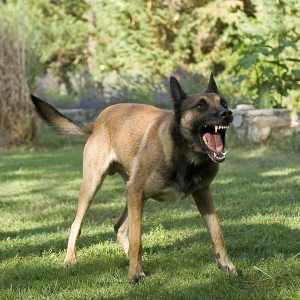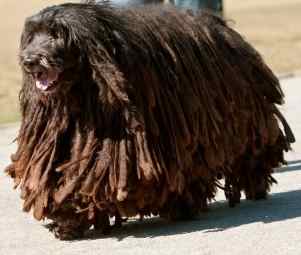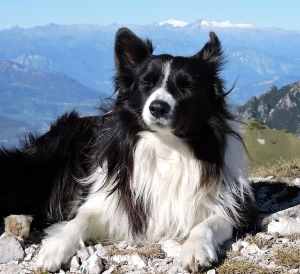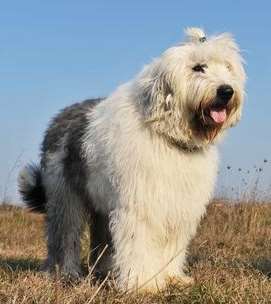The Herding Dog Group includes dogs that were first used when ancient people began keeping livestock. This is one of the oldest dog groups.
In years past, farmers did not depend on fences to keep their herds together, and they didn’t have trucks to transport them to market. Instead, they relied on their dogs.

Want to skip the history, traits, and origins of these breeds?
Skip down to the Herding Breeds
Quick History of the Herding Dog Group
Some herders fulfilled many jobs, serving as guardians, herders, drovers or even hunting dogs. Examples of these multi-tasking dogs include the German Shepherd Dogs, Bouviers des Flandres, Briards and Old English Sheepdogs.
Many others were used primarily to keep the flocks and herds together and serve as a companion for the shepherd or rancher. From the time that ancient people began to keep livestock up to and including the present, farmers needed a way to protect their animals from predators.
Most found that these dogs also served the role of companion. These dogs were preferred because they had a particular kind of predatory instinct which was to herd without harming.
Since they were often left alone with the flock for periods of time, they also needed to possess the ability to make decisions independently. This group of dogs was needed all over the world, where people raised livestock. Many breeds developed separately as a result of the region where they lived.
Small Shetland Sheepdogs were perfect for herding the miniature sheep and horses found in the Shetland Islands off the coast of Scotland. Australian Cattle dogs could withstand the heat of the outback and still survive the long stock drives over rough ground.
Shepherds depended on the dogs to guard their flocks against predators, keep them together and when the time came, drive them to market.
Each breed has its own way of keeping sheep and other types of livestock in tightly packed herds. The Border Collie, for example, uses his hypnotic stare. Others use loud, stern barks. Almost all use that characteristic nipping at the heels to make their charges obey them.
Herding in the 21st Century
These fundamental traits that make them perfect for guarding, herding and driving herds of livestock, are now being employed for 21st-century jobs.
German Shepherds and Belgian Malinois, for example, are sought after as police, military and assistance dogs. They also perform search and rescue.
In rural parts of the world, these dogs are still doing predominantly what they have done for centuries: Help the farmer.
Origins of the AKC Herding Dog Group
The classification of the Herding group has been in existence since 1983 when the American Kennel Club separated their Working group into two distinct categories.
Part of this decision was based on the logical reclassification of breeds. Many dogs that were once in the working group were identified as either sheep or cattle dogs.
These “herders” were placed in the working group initially because they were versatile and could do many different jobs such as guarding, pulling carts and sleds, and even hunting.
What’s in a Name?
You are likely to run across the word, Pastoral, especially if you live in England. The Kennel Club uses this label to include their sheepdogs, cattle dogs, and flock protection dogs. It means basically the same as Herding, but the groups are not identical.
Traits of the Herding Dog Group
The abilities that these dogs possess are a combination of extensive early training and natural instincts.
While most have a strong desire to please, many are stubborn. Those that possess a strong desire to protect will be reserved around strangers.
Having been developed for a very long time to make independent decisions while working, don’t be surprised if they disobey a command if they think it is in the best interest of the situation at hand.
They are territorial, intelligent, and courageous. They strong problem-solving ability may be one of those characteristics that distinguish them from other breed groups.
Most of all, they love attention and have the energy to spare.
Best type of Owner & Living Arrangements
As long as they receive adequate physical and mental exercise, they can live in a variety of settings including the city, suburbs and country.
Most do very well with children, but children should be taught how to treat and respect dogs.
Members of the American Kennel Club Herding Dog Group
Australian Cattle Dog (Blue Heeler, Queensland Heeler)

Originally bred to look after herds of cattle being driven to market over long distances and rough ground. Developed by crossing the native Australian Dingo with Drover’s dogs from England. This is an active and energetic breed that needs plenty of exercise. They are compact and muscular, and normally not difficult to train.
Australian Shepherd

The Australian Shepherd is actually an American dog breed. It is thought to have originated in the Basque region of Spain. When Basque shepherds emigrated to Australia, they took their dogs with them. In later years, the shepherds migrated again, to California.
It was in the USA that the breed was developed further for local conditions, but was still referred to as that “Australian Shepherd”.
Bearded Collie

Origins: Scotland
Size: Medium to Large
Grooming: Extensive
Training: Easy to Moderate
Recognition: AKC (Herding), ANKC (Working Dogs), CKC (Herding), FCI (Group 1), KC (Pastoral), NZKC (Working), UKC (Herding)
Also called: Highland Collie, Beardie
Belgian Laekenois

Origins: Belgium
Size: Large
Grooming: Average
Training: Average
Recognition: AKC (FSS), ANKC (Working), CKC (Herding), FCI (Group 1), KC (Pastoral), NZKC (Working), UKC (Herding)
Also Called Chien de Berger Belge, Laekenois, Belgian Shepherd Dog
The Belgian Laekenois dog breed belongs to a group of 4 Belgian shepherd dogs. They look remarkably similar to each other, and to the German Shepherd, but they are 4 distinct breeds. The Laekenois is the most rare. It is distinguished by a rough, short shaggy coat in red, grey and fawn. Its coat looks like that of the Irish Wolfhound.
Belgian Malinois

Origins: Belgium
Size: Medium
Grooming: Easy
Training: Average
Recognition: AKC (Herding), ANKC (Working), CKC (Herding), FCI (Group 1), KC (Pastoral), NZKC (Working), UKC (Herding)
As breeds go, the Belgian Malinois Dog could very well be the best guard and worker in the canine kingdom. Bred to be a herder, these dogs can take on a multitude of jobs, and they are the favorites among military and law enforcement personnel. Amazingly agile and athletic.
Bergamasco

Also called Bergamasco Shepherd Dog, Bergermaschi, Cane da pastore Bergamasco
Origins: Italy
Size: Large
Grooming: Extensive
Training: Challenging
Recognition: AKC (Herding), ANKC (Working), FCI (Group 1), KC (Pastoral), NZKC (Working), UKC (Herding)
Other Names used: Cane de Pastore
In terms of personality, the Bergamaso Sheepdog (or Bergamasco Shepherd as he is also known) is a friendly, intelligent, peaceful and well balanced breed.
He loves children – his natural herding and protective naturally comes out when he is around kids and the Bergamasco dog breed has been successfully used as a therapy dog for disabled children.
Berger Picard

Origins: France
Size: Large
Grooming: Easy
Training: Moderate
Recognition: AKC (Miscellaneous), CKC (Herding), FCI (Group 1), UKC (Herding) Also called Bacardi Shepherd, Berger de Picardy, Picardy Shepherd
This is a relatively rare breed, with only 500 dogs registered in North America, and around 5000 worldwide. Originally a sheep herding dog from Northern France. They can be a little suspicious of strangers, and need careful socializing up to the age of about 2 years of age. Otherwise they make good apartment dogs as long as they get enough exercise. They rarely bark, and don’t shed much.
Border Collie

Origins: England and Scotland
Size: Medium
Grooming: Average
Training: Easy
Recognition: ANKC (Working), CKC (Herding), AKC (Herding), FCI (Group 1), KC (Pastoral), NZKC (Working), UKC (Herding)
As one of America’s favorite breeds of dog, and ranking 39th on the American Kennel Club’s list of most popular dog breeds, I’m sure most people have heard at least a few of the charming qualities that make this special dog who they are.
Some people might say that this breed is “pretty smart”, and they wouldn’t be wrong, but in fact, this smart dog is considered to be the most intelligent breed on the planet.
Briard

Origins: France
Size: Large
Groom: Average
Training: Average
Recognition: ANKC (Working), CKC (Herding), AKC (Herding), FCI (Group 1), KC (Pastoral), NZKC (Working), UKC (Herding)
Also called Berger de Brie, Chien Berger de Brie
Cardigan Welsh Corgi

Origins: Wales
Size: Medium
Grooming: Average
Training: Time Consuming
Recognition: AKC (Herding), ANKC (Working), UKC (Herding), CKC (Herding), KC (UK) (Pastoral), NZKC (Working), FCI (Group 1)
The Cardigan Welsh Corgi is a popular, compact dog breed. It is one of the two Corgi breeds and is known for its intelligent and silly personality.
These dogs are popular all around the world for their capabilities as a loving lap dog. These little fluffy dogs hold the spot as the 76th most popular breed.
Entelbucher

Also called Entlebucher Cattle Dog, Entlebucher Sennenhund
Origins: Switzerland
Size: Medium
Grooming: Minimal
Training: Average
Recognition: AKC (Herding), FCI (Group 2), KC (Workings), UKC (Guardian), CKC (Working)
German Shepherd

Origins: Germany
Size: Large to Giant
Grooming: Average
Training: Easy
Recognition: FCI: Group 1, AKC: Herding, ANKC: Working, CKC: Herding, KC: Pastoral, NZKC: Working, UKC: Herding
The German Shepherd originated in Germany as a herding dog and was used to herd and guard sheep, but has since gone on to be one of the most recognizable breeds in the World.
They date from around 1899 when they were first shown in the show ring and were introduced into the UK and the USA just after World War I.
Miniature American Shepherd

The German Shepherd originated in Germany as a herding dog and was used to herd and guard sheep, but has since gone on to be one of the most recognizable breeds in the World.
They date from around 1899 when they were first shown in the show ring and were introduced into the UK and the USA just after World War I.
Old English Sheepdog

Origins: Great Britain
Size: Large
Grooming: Time Consuming
Training: Average
Recognition: FCI: Group 1, AKC: Herding, ANKC: Working, CKC: Herding, KC: Pastoral, NZKC: Working, UKC: Herding
Originally bred to drive sheep and cattle to market, the Old English Sheep Dog is intelligent and kind, with a sense of humor. Widely known in the U.K. as ‘the Dulux Dog’ owing to an Old English Sheepdog featuring in the Dulux paint company’s television advertisements.
Polish Lowland Sheepdog

Origins: Poland
Size: Medium
Grooming: Time Consuming
Training: Training
Recognition: FCI: Group 1
Pyrenean Shepherd

Originates in the Pyrenees mountain range between Spain and France.
Spanish Water Dog

Origins: Spain
Size: Medium
Grooming: Time Consuming
Training: Time Consuming
Recognition: FCI: Group 8, AKC: Herding, KC: Herding, NZKC: Gun Dogs, UKC: Gun Dogs
Members of the Herding Dog Group, Not Recognized by AKC
- Australian Kelpie
- Belgian Groenendael
- Berger de Beauce
- Bouvier Des Ardennes
- Cao Da Serra De Aires (Portuguese Sheepdog)
- South Russian Shepherd Dog
- Catalan Sheepdog
- Croatian Shepherd Dog
- Caucasian Shepherd
- Czechoslovakian Wolfdog
- Dutch Schapendoes
- Dutch Shepherd Dog
- Majorca Shepherd Dog
- Mudi
- Pumi
- Romanian Carpathian Shepherd Dog
- Schipperke (Listed as Non sporting by AKC)
- Slovakian Chuvach
- Tatra Shepherd Dog
- White Swiss Shepherd Dog
Want to learn More About the Herding Dog Group?
There are quite a few books written on this subject and include histories and breed profiles to training manuals for those who want to training their own dog for work in the field as well as dog events.
Here are a few that I picked out. Click on the image to find out more information.



